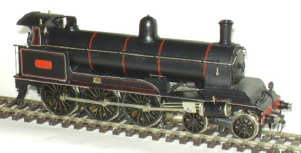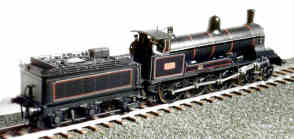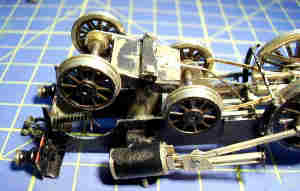'Bill Bailey' Class, No 1113
I am sometimes told, at model railway exhibitions, by spectators knowledgeable in LNWR matters, that this loco should not be running on my layout. They are perfectly correct! The first "Bill Bailey" did not appear until 1903 and No 1113 was not built until 1904. My excuse is that it is such a weird and wonderful prototype that I just had to build a model of it and, on my railway, I can run what I like. Most viewers are pleased to see one actually running.
This class was the last Webb design to appear from Crewe Works and, also, one of the least successful. It was intended to be a mixed traffic loco and was basically a Class B 4-cylinder compound fitted with larger wheels and with a double radial truck in place of the leading driving wheels. The increase in wheel diameter of 9 inches had the effect of raising the boiler, cylinders and footplate by 4.5 inches but, because the height of the buffers and the tender floor had to remain unaltered, concave sections were added at the extremities of the footplate. The resulting loco, to me, looks to be all legs!
Whale allowed 30 to be built, the last in 1905, but they earned a bad reputation for reliability, hence their nickname. The first was scrapped in 1913. Many were cannibalised during the First World War to keep Class B compounds running, and the last was cut up in 1920.
Having already adapted an LRM C/C1 kit into a Class B compound, turning the same kit into the superstructure of a "Bill Bailey" was not a great problem. The chassis was rather more so. With a short coupled wheelbase and a long front overhang I foresaw difficulties getting it to go round 3 ft. radius curves. However, I knew from experience that the Class B would traverse such curves, so I decided to build the "BB" as an 0-8-0 with a front pony truck. The rear bogie wheels are, in fact, mounted in the main frames although they are provided with considerable side play. The motor, the inevitable LH21, drives the centre driving axle and the front and rear driving axles are sprung. The main weight of the loco rests on the rear bogie axle and the centre drivers. It stays on the track and pulls well. Pickup is from the rearmost eight wheels.
The loco weighs 330grms and it exerts a pull of 45grms.


What a curious looking loco!
It looks better from the rear


When the body is put on, the chassis sinks down onto the rear bogie axle
The pony truck hangs on the end of a length of springy wire